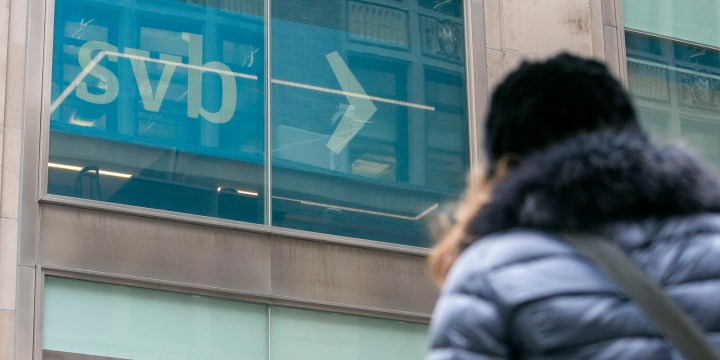GUEST ESSAY
Silicon Valley: The biggest bank run in history — and a tale of two unlikely bedfellows

The shocking collapse of Silicon Valley Bank — with its $16bn stock market cap — came just hours after the collapse of a much tinier bank.
The Silicon Valley Bank (SVB), the US’s 16th largest bank with $212-billion in assets, suddenly and shockingly collapsed last week. It happened in just 48 hours.
It is the biggest bank collapse in the US since the 2008 financial crisis. Nobody is ignoring the sickening sense of déjà vu.
This is huge news and I suspect it might be the beginning of something awful starting this week (perhaps even globally awful). It is made even more interesting in the face of the collapse of a much tinier bank almost just hours earlier. That was Silvergate Bank, one of only two banks willing to do business with crypto exchanges.
Let’s start with Silicon Valley Bank, a favourite of the West Coast hi-tech community and home to many wealthy tech entrepreneurs, well-known valley businesses and VC-funded start-ups.
SVB’s banking services were pretty much standard, even though it catered mainly for the cash-rich tech world. It was also most definitely not a player in the crypto world, but was a rather frequent destination for cash-rich tech start-ups. Bloomberg columnist Matt Levine has called the SVB “the Bank of Start-Ups”.
But the road from trusted traditional-style bank to Harvard Business School failure case study was surprisingly simple. And avoidable.
The breakdown
Here’s the story. When the pandemic poked its ugly nose into world affairs, the US government accelerated the provision of new dollars into the economy (known as QE4), supplying liquidity to cushion the economy from the effects of the slowdown.
So much money was injected into the economy ($1.6-trillion in two years, including money sent straight to citizens’ bank accounts), that many banks became bloated with deposits.
This included Silicon Valley Bank. So much so (more than $130-billion in deposits in 2020/21) that it could not find enough takers to lend all its swag to. So it did the prudent thing and deposited the money in low-interest, zero-risk long-term government bonds. Yawn, but safe.
Roaring inflation beast
Then Jerome Powell at the Federal Reserve started raising interest rates fast to slay the growing inflation beast. So naturally, banks began raising the rates they offered to depositors.
SVB, however, was stuck. It had tied up hundreds of billions in low interest-rate bonds, so offering higher interest rates to depositors would squeeze its profits, so it kept deposit rates low.
So what did your average SVB account holder do, including cash-rich start-ups? They left the bank in droves to find more attractive interest rates offered at the bank down the road.
By the time SVB had exhausted other alternatives to shore up its dwindling reserves and finally decided to sell its bonds (at a painful loss), the bank run had already taken root. And then the news cycle and doomsayers. And then more withdrawals. And then more public alarm.
Run, bankers, run
And then … poof! SVB was gone (or at least temporarily shut down and placed under admin by regulators). Bank runs do not happen over years, they happen over days.
To give you an idea of how bad this bank run was – on Thursday, 9 March, $42-billion was withdrawn in 10 hours. That’s $4.2-billion an hour. I don’t even know how to compute that. To compare: this was more than three times the size of the largest previous bank run, that on Washington Mutual in 2008.
Many individual depositors will be protected by the Federal Deposit Insurance Corporation (FDIC), which is government insurance up to $250,000. Many others, including corporate accounts, will not.
The value destruction is immense; SVB had a $16-billion stock market cap a few weeks back. Others are going to be caught in this sinking ship because as we know, capital is entangled over long chains of counterparty dependencies. When a big bank sinks, many connected parties drown.
The fallout
The financial crisis wrought by SVB will start this week, possibly as you are reading this.
Nic Carter, one of the most sober and closely followed financial commentators, Tweeted: “everyone I know including myself will be wiring funds to the largest bank they have a relationship with on Monday morning.”
everyone I know including myself will be wiring funds to the largest bank they have a relationship on Monday morning
it’s not “will it become systemic” it was systemic when the 16th largest bank failed and FDIC and Fed dithered about stepping bc “Silicon Valley” & “tech bros”
— nic carter 🌠 (@nic__carter) March 12, 2023
The regional banking system will see carnage and it will likely reach Europe and beyond.
‘Orderly unwinding’
Which brings us to Silvergate Bank. Unlike SVB, its relationship with crypto exchanges was a large part of its business. It allowed these exchanges to open accounts at Silvergate, thereby enabling the rails by which crypto investors could move between the old world and the new.
The Silvergate Bank collapse (actually an “orderly unwinding” at this point) had a somewhat similar trajectory to SVB, save for details. Sudden rise in interest rates also caught it with its pants down, and the crunch ensued.
It has little to do with crypto per se, but, like SVB, it’s simply a matter of mismanaging an oversupply of capital.
The entire mess – at both banks – stems from the fine art of risk management. Although regulators are fairly strict about what banks may or may not do with their capital (how much they can loan out, how much they must keep on reserve, etc), there is also considerable leeway for banks to stretch their available dollars this way and that.
The best stretchers live long and happy lives, the worst end up with catastrophes like the ones we have just seen.
Risk management
This world of financial risk management is often seen as opaque. But it really boils down to this: Banks take in deposits and pay interest. They loan out capital and charge interest. They also invest their spare capital in various markets. Each one of these decisions must be weighed against the terms of lend/borrow arrangements, interest to be paid/received, assets on hand, creditworthiness of counterparties, and – critically – an educated guess as to which way interest rates are going to move.
This last item is the only one outside a bank’s control. It is a periodic decision of the Federal Reserve.
These banks misread the signals and locked themselves into losing money. It was that simple.
A passing snipe is in order. When Silvergate failed, a whole section of the crypto-hating gallery shivered with gleeful schadenfreude. Serves you right, they said, for playing with crypto bros.
Then SVB failed, not a bitcoin in sight. Now who are you gonna blame?
Financial risk management is financial risk management, no matter where you play.
Oh, and buckle up, this is not going to be pretty. DM
Steven Boykey Sidley is a professor of practice at the Johannesburg Business School, University of Johannesburg.

















Really bad treasury management. In effect they had lots of savings that are by nature mostly short term – people can take it out immediately, and other side they invested that in long-duration bonds. To make matters worse, the say $100 coupon 1% 2040 treasury bonds they bought became $90 on the resale market when interest rates jumped to 6%.
People with money in SVB will now be OK as the US government stepped in on Sunday to provide liquidity against their own bonds as collateral for the liquidity. The shareholders and bond holders in SVB are toast. Management have some questions to answer. The CEO and CFO sold shares as recently as end February, when they’d have known their $200 billion bond portfolio is worth $20 billion less = the entire market cap of the bank.